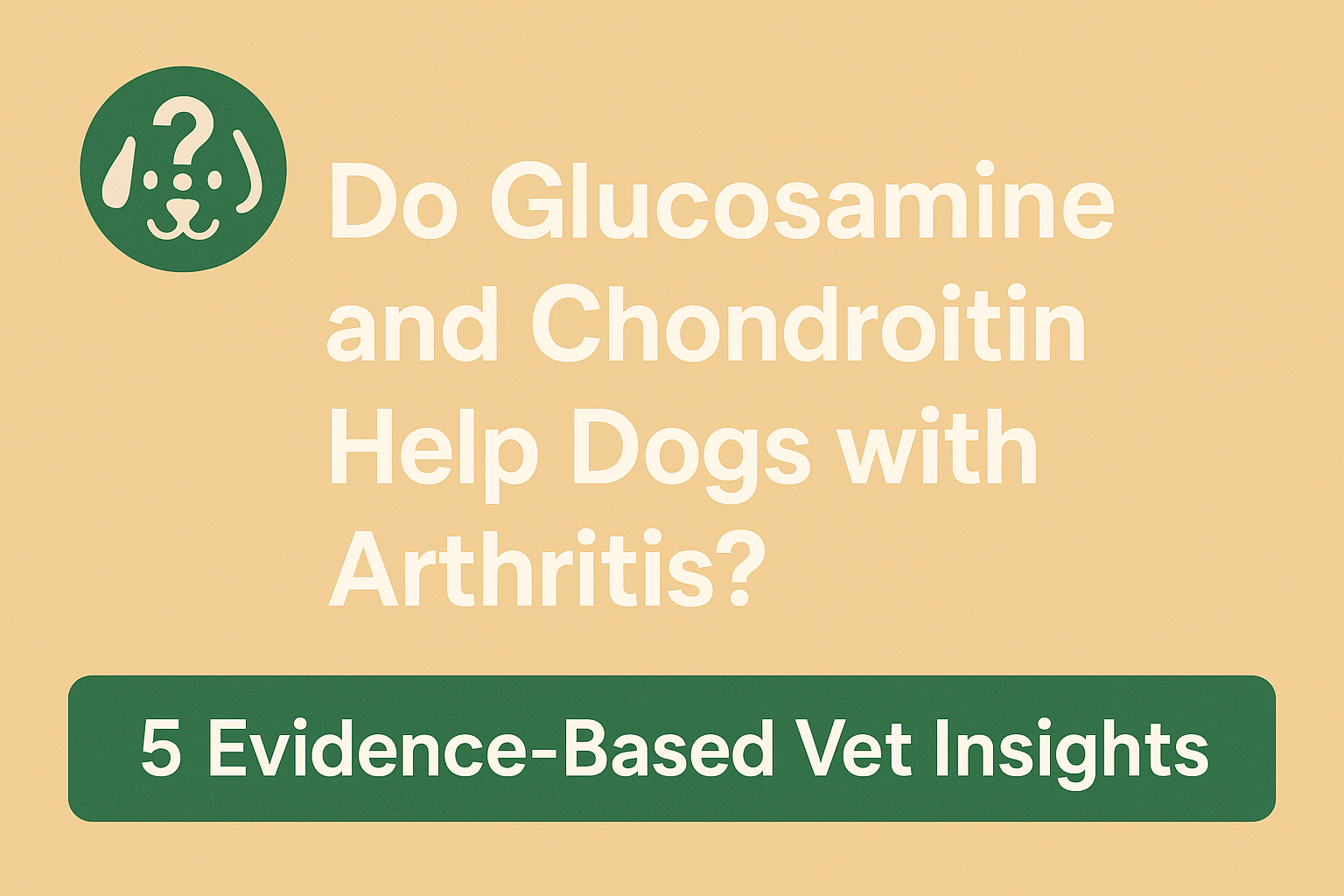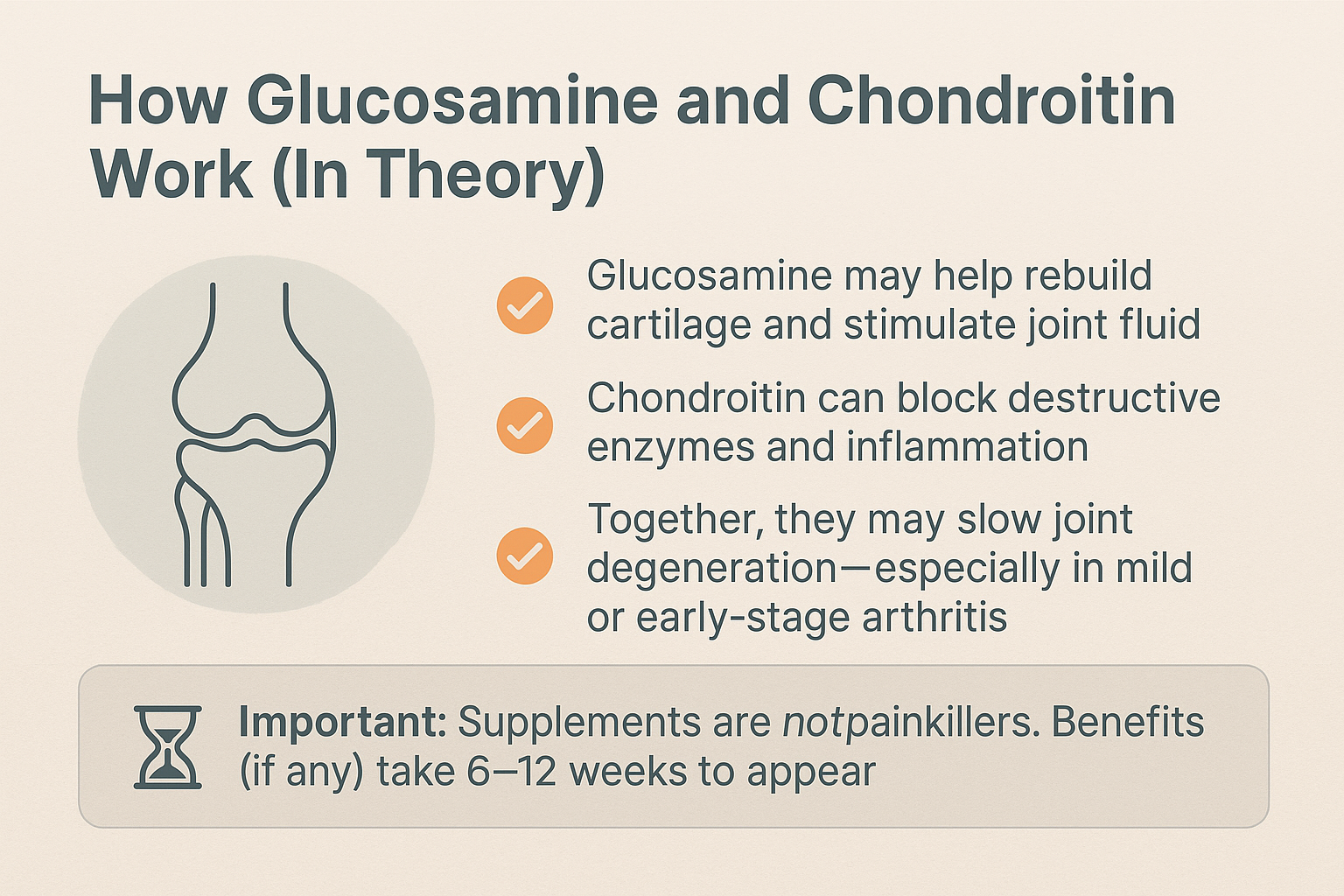Introduction: What Dog Owners Want to Know
If your dog is slowing down, hesitant on stairs, or stiff after a nap, arthritis might be creeping in. One of the first treatments most pet parents hear about is glucosamine and chondroitin—but do these joint supplements really help dogs, or are they just well-marketed myths?
Veterinarians often recommend them as a first-line, low-risk option for managing early joint changes. But the truth is more nuanced. Some dogs improve; others don’t. In this article, we break down what current veterinary research shows, explain how glucosamine chondroitin for dogs is thought to work, and offer honest, vet-backed guidance so you can make the best decision for your pup’s joint health.
📚 Some clinical studies suggest mild benefits for pain and mobility—especially in early osteoarthritis (McNamara et al., 2006).
Table of Contents
✅ Key Takeaways
- Glucosamine and chondroitin may help dogs with early-stage arthritis, especially when used consistently and alongside other treatments.
- Evidence is mixed. Some studies show improvements in mobility and comfort, while others find minimal to no effect.
- Supplements take time—expect 6–12 weeks to see results if they’re going to work.
- Vet guidance matters. Not all products are equal; quality, dosage, and formulation vary widely.
- They’re not painkillers. Think of these as slow-acting joint protectants—not quick fixes for severe arthritis.
- Generally safe for long-term use, but high doses or human supplements can be harmful.
- Look for NASC-certified supplements and always discuss options with your veterinarian.
🧪 What Are Glucosamine and Chondroitin?
Glucosamine is a naturally occurring amino sugar found in healthy cartilage, especially in the fluid around joints. Chondroitin sulfate is a major component of cartilage that helps it retain water and flexibility.
In dogs, these compounds are often combined in supplements marketed to support joint health. You’ll find them in chewable tablets, powders, or soft chews—sometimes with added ingredients like MSM (methylsulfonylmethane) or hyaluronic acid to further enhance joint support.
Together, glucosamine and chondroitin are classified as glycosaminoglycans (GAGs)—substances believed to help slow cartilage breakdown and support joint lubrication.
🩺 Vet Fact: Most joint supplements for dogs include glucosamine hydrochloride (HCl) rather than the sulfate form due to better stability and absorption. Many also include chondroitin sourced from bovine or porcine cartilage (Dobias, 2023).

🐾 What the Research Says: Do These Supplements Actually Work?
✅ Some Studies Show Improvement
There is some evidence that glucosamine and chondroitin can help dogs with osteoarthritis—particularly in early stages.
- A 70-day controlled trial found dogs receiving glucosamine HCl and chondroitin sulfate had improved pain scores and mobility compared to placebo (McNamara et al., 2006).
- Another study evaluating a supplement blend—including glucosamine, chondroitin, collagen, and botanicals—showed anti-inflammatory effects and improved gait analysis in dogs with joint pain (de Andrade et al., 2022).
💡 Improvement was most noticeable after 6 weeks, with continued gains at 10 weeks.
⚠️ But Evidence Is Mixed Overall
Despite these promising findings, many experts caution that results across studies are inconsistent:
- A review of veterinary joint supplement trials noted low-quality evidence, inconsistent methodologies, and variable outcomes, urging more rigorous research (Sanderson et al., 2014).
- Similarly, a Veterinary Journal article concluded that while some dogs benefit, overall clinical efficacy remains questionable (Neilson et al., 2014).
🧑⚕️ Vet Perspective: “In my own practice, I’ve seen older dogs perk up after starting these supplements—but it’s not consistent across the board.”
🧬 How Do Glucosamine and Chondroitin Work?
These compounds aren’t painkillers. Instead, they aim to support and preserve joint structure over time.
- Glucosamine is thought to stimulate cartilage-producing cells and promote synthesis of joint lubricants like hyaluronic acid.
- Chondroitin sulfate may inhibit enzymes that break down cartilage and reduce inflammation within the joint capsule.
Combined, they’re believed to slow the progression of osteoarthritis, particularly when started in the early stages.
⏳ Important: Clinical effects take time. Most dogs require at least 6–12 weeks before potential benefits appear—and some may not respond at all (Dobias, 2023).
Their slow-acting nature means these supplements are best used as part of a long-term management plan, rather than an acute pain solution.

🛑 What Are the Limitations?
While glucosamine and chondroitin for dogs are widely used in veterinary practice, their limitations deserve honest discussion.
🚫 Known Drawbacks:
- Variable product quality: Many over-the-counter supplements lack consistent dosing or purity.
- Poor absorption: Oral glucosamine has relatively low bioavailability, especially in large dogs.
- Slow onset: These are not quick fixes—dogs may need weeks or months before any improvement is seen.
- Less effective in advanced arthritis: Severe cartilage loss or bone-on-bone contact typically requires stronger interventions.
A major concern is the lack of regulation. One study pointed out that many dog supplements don’t contain the labelled amounts of active ingredients (Davidson et al., 2006). Reviews also emphasize that methodological flaws—small sample sizes, lack of controls—limit how much we can trust the results (Sanderson et al., 2014).
🔬 “Despite being a common recommendation, the clinical impact of these supplements remains uncertain in many cases.” – VCNA-SA, 2014
🩺 Should You Use Glucosamine and Chondroitin for Dogs?
Vets often consider joint supplements like glucosamine and chondroitin as part of a broader arthritis care strategy—especially in early stages. But when are they worth using?
📊 When It Might Help
| Stage of Arthritis | Supplement Benefit |
|---|---|
| Mild / Early OA | ✅ Likely beneficial as joint support |
| Moderate OA | ⚠️ May help when combined with other care |
| Severe / End-stage OA | ❌ Unlikely to provide meaningful relief |
✅ Good Use Cases:
- Your dog is showing early stiffness or reluctance to exercise
- You’re hoping to delay prescription medications
- You want to support joints as part of multimodal care: weight management, exercise, rehab, and vet-monitored supplements
⚠️ Be Cautious If:
- Your dog already needs strong pain medications
- You’re expecting fast or dramatic results
- You’re buying supplements without vet input or from non-reputable brands
🧠 Pro Tip: Look for NASC (National Animal Supplement Council) certified products, which have undergone quality control (Dobias, 2023).

🔐 Safety and Side Effects
Most dogs tolerate glucosamine and chondroitin well—making them a relatively safe long-term option. But like any supplement, they aren’t risk-free.
✅ Generally Safe:
- Can be used with NSAIDs and other joint treatments
- Safe for long-term, daily use under veterinary supervision
- Rare side effects: mild GI upset (soft stools, vomiting)
⚠️ Use With Caution:
- Overdose risks: Too much glucosamine (especially from human products) can lead to liver toxicity or GI damage
- Hidden ingredients: Some pet supplements contain additives or flavourings that may not suit sensitive dogs
🚨 A case report described a dog developing serious organ damage after ingesting a high dose of a glucosamine-chondroitin product intended for humans (Tarantino et al., 2023).
🐶 Always:
- Use veterinary-formulated products
- Avoid human supplements unless explicitly advised by your vet
- Stick to recommended doses—even if you miss one
🐕 Real-World Tips for Dog Owners
Thinking of starting glucosamine and chondroitin for your dog? Here’s how to do it wisely:
✅ DO:
- Talk to your veterinarian before starting any supplement
- Choose a reputable, vet-formulated product—ideally one with NASC certification
- Track your dog’s response: changes in energy, mobility, and stiffness
- Give the supplement at least 8–12 weeks before evaluating its effect
❌ DON’T:
- Expect it to replace prescription pain relief in moderate or severe cases
- Assume results will be immediate
- Use human-grade supplements or adjust dosages without guidance
- Double dose if you miss one—just resume as normal
🐾 Vet Insight: “We often use these supplements preventively, especially in large breeds or aging dogs. They’re rarely harmful, but the key is using a quality product and being patient.”
✅ Final Verdict: Do Glucosamine and Chondroitin for Dogs helps with Arthritis?
Sometimes—especially early on.
Glucosamine and chondroitin can help dogs with mild to moderate osteoarthritis, particularly when part of a larger wellness plan that includes weight control, proper exercise, and regular vet care.
They’re not painkillers, and they won’t rebuild destroyed cartilage—but for many dogs, they can slow joint deterioration and improve comfort over time.
🐶 “In my own patients, I’ve seen noticeable improvements—less stiffness, better mobility—but only when used early and consistently. They’re one tool among many.” – Dr. [Your Name], DVM
Bottom line: These supplements may not work for every dog, but they’re generally safe and often worth trying—with your vet’s guidance.
📚 References
- Neilson, R. et al. (2014). Veterinary Journal – Clinical Efficacy of Joint Supplements
- Davidson, A.P. (2006). Veterinary Clinics: Small Animal Practice – Nutraceuticals in Arthritis
- AVMA (2019). Journal of the American Veterinary Medical Association – Arthritis Management in Dogs
- Sanderson, R.O. et al. (2014). Veterinary Clinics: Small Animal Practice – OA Supplement Review
- Dobias, P. – Glucosamine and Chondroitin for Dogs: A Vet’s View
- de Andrade et al. (2022). Advances in Small Animal Care – Joint Support Trial
- Tarantino et al. (2023). Journal of the American Animal Hospital Association – Glucosamine Overdose Case




